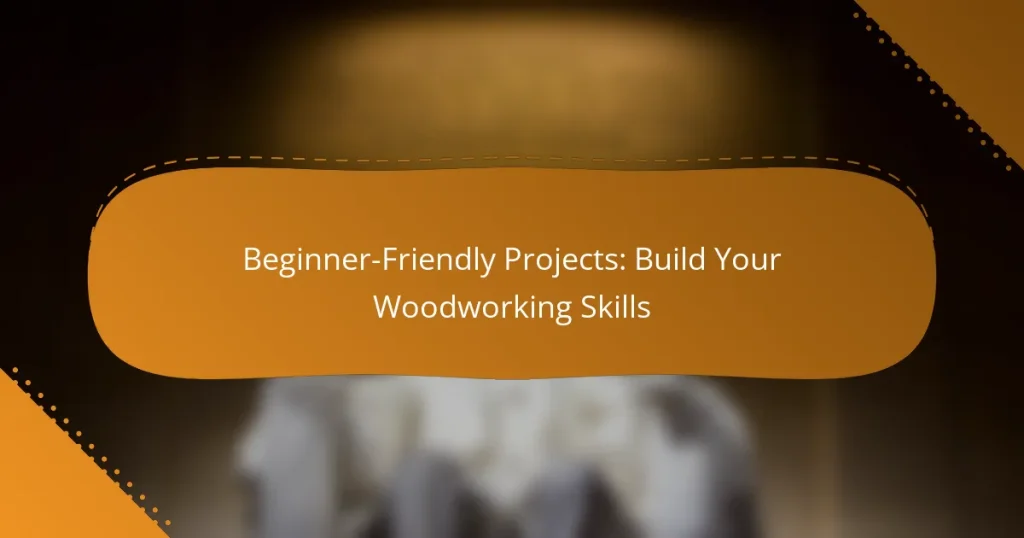Embarking on your woodworking journey can be both exciting and rewarding, especially with beginner-friendly projects that enhance your skills. Simple tasks like building birdhouses or planter boxes not only provide a sense of accomplishment but also require minimal tools and materials, making them perfect for novices. By focusing on essential tools and basic techniques, you’ll quickly gain confidence and proficiency in crafting your own wooden creations.

What are the best beginner woodworking projects?
The best beginner woodworking projects are simple, manageable tasks that help develop essential skills while providing a sense of accomplishment. Projects like birdhouses, planter boxes, bookshelves, picture frames, and step stools are ideal for novices, requiring minimal tools and materials.
Simple birdhouse
A simple birdhouse is an excellent first project for beginner woodworkers. It typically requires basic materials like wood boards, nails, and paint, and can be completed in a few hours. Plans for birdhouses are widely available online, often including dimensions and assembly instructions.
When building a birdhouse, consider the type of birds you want to attract, as different species have varying preferences for size and entrance hole dimensions. Use untreated wood to ensure safety for the birds, and remember to drill drainage holes to keep the interior dry.
Wooden planter box
Creating a wooden planter box is another straightforward project that allows beginners to practice cutting and assembling techniques. These boxes can be customized in size and design, making them suitable for various plants or flowers. Basic materials include untreated lumber and screws or nails.
Ensure proper drainage by drilling holes in the bottom of the planter. If you plan to use it outdoors, consider applying a non-toxic sealant to protect the wood from moisture and weather damage.
Bookshelf
A bookshelf is a practical project that can enhance any room while providing valuable woodworking experience. Beginners can start with a simple design that requires just a few shelves and side panels. Standard dimensions for a small bookshelf are around 30 inches tall and 24 inches wide.
When constructing a bookshelf, use sturdy wood like pine or plywood, and ensure that the shelves are adequately supported to hold books without sagging. Consider adding a back panel for stability and a finished look.
Picture frame
Building a picture frame is a fun and creative way to practice woodworking skills. This project typically involves cutting four pieces of wood to create the frame’s border, which can be customized to fit any photo size. Simple miter cuts at the corners can add a professional touch.
For a polished finish, sand the edges and apply paint or stain to match your decor. Use glass or acrylic for the front, and consider adding a backing board to secure the picture in place.
Step stool
A step stool is a functional project that is both practical and easy to build. It usually consists of a flat top and two side supports, with a height of about 12 to 18 inches. This project helps beginners learn about stability and weight distribution.
Ensure that the stool is sturdy by using thicker wood for the top and supports. Sand all edges to prevent splinters, and consider adding a non-slip surface for safety. This project can be completed in a weekend, making it a rewarding choice for new woodworkers.

How can I get started with woodworking?
To get started with woodworking, focus on acquiring essential tools, selecting a suitable workspace, and learning basic techniques. These foundational steps will help you build your skills and confidence in crafting wooden projects.
Gather essential tools
Begin by collecting the basic tools necessary for woodworking. A good starter set typically includes a saw, a hammer, a tape measure, chisels, and sandpaper. You can find these tools at local hardware stores or online, often at reasonable prices.
As you progress, consider adding more specialized equipment like a drill, clamps, and a workbench. Investing in quality tools can enhance your experience and results, so look for reputable brands that offer durability.
Choose a workspace
Selecting the right workspace is crucial for effective woodworking. Ideally, you need a well-ventilated area with ample lighting and enough room to maneuver your tools and materials. A garage, basement, or dedicated workshop can serve as a suitable environment.
Ensure your workspace is organized and free from clutter. Having a designated area for tools, materials, and projects will help you stay focused and efficient. Safety is also important, so consider having a first aid kit and fire extinguisher nearby.
Learn basic techniques
Start by mastering fundamental woodworking techniques such as measuring, cutting, joining, and finishing. Online tutorials, books, and local classes can provide valuable guidance and demonstrations. Practice these skills on small projects to build your confidence.
Common beginner projects include simple shelves, birdhouses, or picture frames. These items allow you to apply basic techniques while creating something functional. As you gain experience, gradually take on more complex projects to further develop your skills.

What tools do I need for beginner woodworking?
For beginner woodworking, essential tools include a table saw, power drill, measuring tape, and clamps. These tools will help you make accurate cuts, assemble projects, and ensure precision in your work.
Table saw
A table saw is a versatile tool that allows for straight cuts on large pieces of wood. It features a circular blade mounted on an arbor, which can be adjusted for depth and angle, making it ideal for various cuts like rip cuts and crosscuts.
When selecting a table saw, consider factors such as size, portability, and safety features. A good starter model might range from $300 to $800, depending on the brand and capabilities.
Power drill
A power drill is crucial for drilling holes and driving screws in woodworking projects. Cordless models offer flexibility and ease of use, while corded versions provide consistent power for heavy-duty tasks.
Look for a drill with adjustable speed settings and a variety of drill bits. Prices typically range from $50 to $200, depending on the brand and features.
Measuring tape
A measuring tape is essential for ensuring accuracy in your woodworking projects. It allows you to measure lengths, widths, and heights precisely, which is critical for fitting pieces together correctly.
Choose a tape that is at least 25 feet long and has clear markings. A sturdy, retractable tape will last longer and provide more accurate measurements, typically costing between $10 and $30.
Clamps
Clamps are vital for holding pieces of wood together while glue dries or during assembly. They come in various types, including bar clamps, pipe clamps, and C-clamps, each serving different purposes.
Invest in a few different types to accommodate various project sizes. A set of clamps can range from $20 to $100, depending on the type and quality.

What are the common mistakes beginners make?
Beginners in woodworking often encounter several common mistakes that can hinder their progress and safety. Being aware of these pitfalls can help new woodworkers improve their skills and enjoy the craft more effectively.
Skipping safety gear
One of the most critical mistakes beginners make is neglecting to wear proper safety gear. Essential items like safety glasses, ear protection, and dust masks protect against injuries and long-term health issues from wood dust and noise.
Always prioritize safety by investing in quality gear. For example, safety glasses should meet ANSI Z87.1 standards, and dust masks should be rated for fine particles. This simple step can prevent accidents and ensure a safer working environment.
Not measuring accurately
Inaccurate measurements can lead to wasted materials and frustrating mistakes in woodworking projects. Beginners often rush this step, resulting in pieces that do not fit together properly.
To avoid this, use a reliable tape measure and a square for checking angles. A good rule of thumb is to measure twice and cut once. This practice helps ensure precision and saves time and resources in the long run.
Choosing complex projects
Beginners frequently select projects that are too advanced for their skill level, leading to discouragement and unfinished work. It’s essential to start with simpler designs that allow for gradual skill development.
Consider starting with basic items like a birdhouse or a simple shelf. These projects help build confidence and foundational skills without overwhelming the beginner. Gradually increase complexity as skills improve, ensuring a more enjoyable learning experience.

How can I improve my woodworking skills?
Improving your woodworking skills involves consistent practice, learning from experts, and utilizing available resources. By engaging in hands-on projects and seeking guidance, you can develop your techniques and confidence in woodworking.
Practice regularly
Regular practice is essential for honing your woodworking skills. Set aside dedicated time each week to work on projects, even if they are small. This consistent effort will help you build muscle memory and improve your precision.
Start with simple projects like birdhouses or small shelves, gradually increasing complexity as you gain confidence. Aim for at least one project every month to keep your skills sharp and your creativity flowing.
Join woodworking classes
Joining woodworking classes can provide structured learning and valuable feedback from experienced instructors. Look for local community colleges, craft centers, or woodworking clubs that offer classes tailored to beginners.
Classes often cover essential techniques, tool usage, and safety practices, which are crucial for developing a solid foundation. Engaging with fellow woodworkers can also inspire you and expand your network within the woodworking community.
Follow online tutorials
Online tutorials are a fantastic resource for improving your woodworking skills at your own pace. Websites, YouTube channels, and woodworking forums offer a wealth of instructional videos and articles that cover various techniques and projects.
When selecting tutorials, choose those that match your skill level and interests. Many platforms allow you to interact with instructors and other learners, providing opportunities for questions and discussions that enhance your understanding.


